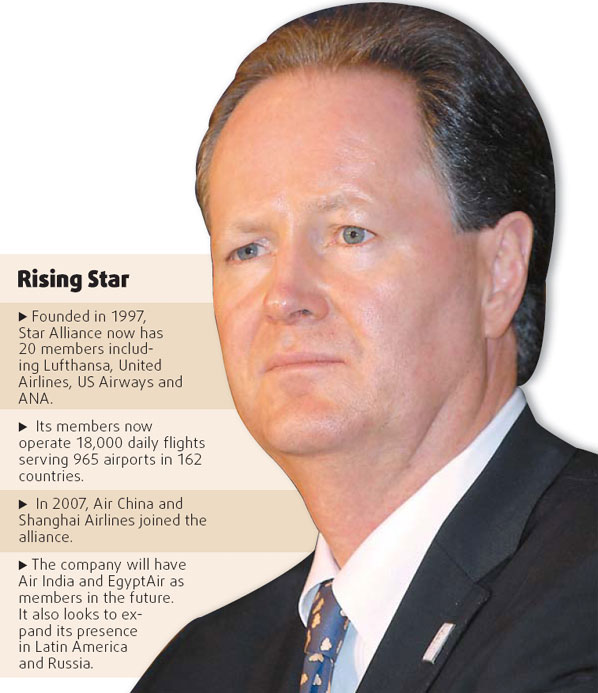Star Alliance builds up BRIC by brick
Since its inception in 1997, Star Alliance has grown into the world's largest airline alliance. Its 20 members now carry about 30 percent of all air travelers in the world every day.
In recent years, the alliance has been trying to expand into the world's fastest growing aviation markets. Last year, it got Air China and Shanghai Airlines on board and also expects to bring Air India, EgyptAir and Brazil's TAM Airlines into its fold in the next two years.
Turkish Airlines is the latest entrant, joining the alliance on April 1. The Istanbul-based company carried nearly 20 million passengers in 2007 and reported a passenger growth of 23.5 percent during the period. With 102 aircraft, it's now one of the fastest growing carriers in Europe.
At a ceremony to mark Turkish Airlines' entry into the alliance, Jaan Albrecht, CEO of Star Alliance, talked with China Daily reporter Wang Xu about the airline network's growth strategy.
Q: How will Turkish Airlines' entry into Star Alliance benefit your other members?
A: For Star members, Turkish Airlines means 31 new destinations. These are mostly in Turkey and the Middle East and were not operated by our other members previously. So the entry of Turkish Airlines helped our members access these regions.
There are other Middle Eastern carriers like Gulf Air that are also interested in joining our alliance. But their aim is to build a hub in Abu Dhabi. Our aim is only to gain access to the cities in the region, rather than build a hub in the desert. Actually EgyptAir will also enter Star Alliance later, which will strengthen our presence in the region.
Q: Going forward, what's Star Alliance's expansion strategy?
A: We have mapped out how to grow and where to grow. We are now focusing on the BRIC nations: Brazil, Russia, India and China. These are major economies with fast economic growth, and their air travel markets are also expanding rapidly.
We have so far covered China, and Air India will join the alliance next year. Currently, Russia's aviation sector is undergoing a restructuring, which makes it difficult for us to grow our membership there. So we have to focus on Brazil and Latin America. We will announce a tie-up with TAM Airlines in Brazil this year. They are now adding more aircraft to their fleet and will start operating more international flights.
Lufthansa and United Airlines have already joined forces with TAM, which makes it easier for the Brazilian carrier to join the alliance.
Q: Apart from the BRIC nations, are there any other markets you are interested in?
A: Yes, there are some fast-growing niche markets that we are interested in, such as Turkey and Egypt. However, our real focus is the BRICs.
Q: Star Alliance now has 20 members and is the largest alliance of its kind. How do the members coordinate among themselves?
A: Star Alliance is the most experienced alliance and we are now in our 12th year, which gives us a lot of experience and first-mover advantage. Our members, both the founding ones and the rest, are very dedicated. A key distinction between us and some other alliances is that we have clearly defined roles for the alliance and the members.
We manage to bring all members together and develop the correct strategy with them and implement it.
To ensure cooperation between the members, we start from the very beginning. For example, an airline needs to get the approval from all existing members to enter the alliance, in a secret ballot. So over the years, we have been able to adapt to the mergers and acquisitions in the industry and progress with them.
Q: Now that you have Air China and Shanghai Airlines in China, what's your next focus in the nation?
A: We are happy with the first four months of our alliance with Air China and Shanghai Airlines. We are now working to expand our geographical advantage in the nation. China has more than 110 airports and we want to extend the alliance's benefits to all of them. For example, we need to put our logos on all the waiting lounges, integrate the ticketing systems and so on.
Q: A number of mergers and acquisitions have taken place in the international aviation market. How will these consolidations affect Star Alliance?
A: The mergers and acquisitions are taking place mainly due to strategic development and vision of the airlines. Membership to different alliances is not what is driving these deals. Actually these deals usually have limited impact on Star Alliance. Our members are free to join forces with airlines of other alliances. For example, Air China has cooperation with Cathy Pacific, which is not our member.

(China Daily 04/22/2008 page15)














